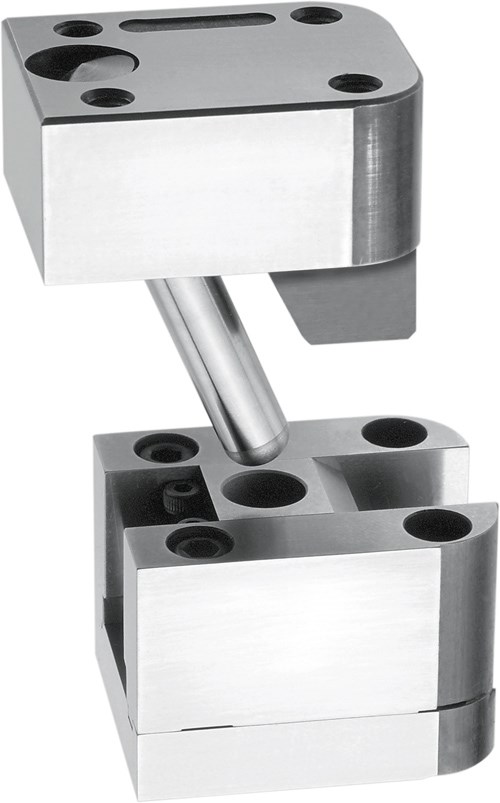Consider the Advantages of Using Standardized Slides
The benefits of using standard slide assemblies are realized by the moldmaker and the molder. It is a proven way to save time and money for both users.
For more than a decade, moldmakers and molders have had the opportunity to use standardized slide assemblies/side actions in their mold designs.
For the Moldmaker
The advantages quickly became clear to those forward-thinking moldmakers who were looking for innovative ways to incorporate value-added items at lower costs than they could build in-house with their own manpower.
Low Cost. Standardized slides offer high quality at low costs. Inventoried standard slides allow the moldmaker to put off ordering components until later in the project, which allows for stretching out payments. As the mid-2000s approached, this advantage became even more valuable.
Decrease Design Time. Another benefit moldmakers quickly discovered was the timesavings gained in design. Designers could easily download files for completed slide assemblies and quickly insert them into their mold design. There was no need to spend valuable resources on designing custom slide assemblies for each mold.
Less Installation Time. Because standard slides are supplied hardened and finish ground (except for fitting stock on a few surfaces), the time spent actually installing these units into the mold are greatly reduced when compared to designing, building and fitting custom slides.
No Scrap. When a moldmaker chooses to use standard slides, he does not need to be concerned with incurring the cost of scrap—there is no possibility of manufacturing scrap when buying off-the-shelf slides.
Less Labor. The labor advantages are also important. With many companies downsizing staff within their mold manufacturing operations over the past few years, it is more important than ever to use talented moldmakers on the finer details of the mold—working on intricate molding detail, finish grinding delicate swipes by shut offs and tightening up fits are all jobs that cannot be standardized. These details take the expertise only available from the hands of qualified moldmakers with a high degree of talent. This is where companies make their money and for what the customer is ultimately paying. A moldmaker does not have to worry about designating manpower to manufacture these components. Using as many standard off-the-shelf items as possible can reduce leadtimes and increase profits by maximizing your available shop hours.
“Basilius, Inc. (Toledo, OH) has been using standardized slide assemblies1 for more than 10 years. The use of these slides has saved us time in design because we don’t have to re-engineer all the components of a cam slide assembly. We also save time in the mold building process, due to the purchase of these components as finished items. The different size selections cover most of our cam slide applications,” says Scott Basilius, President of Basilius, Inc.
For the Molder
Molders have also become more dependent on standardized mold components. Slides and side actions are no exception.
Less Downtime. Over time many molders have discovered the time and cost savings of having standard slide assemblies built into their tools. As with any mechanical device over time, wear and tear can take its toll. Replacing a standard slide versus going back to the moldmaker to have a custom slide re-built and installed can save money, and more importantly time. For a molder, the real savings is in getting the mold back in the machine making parts. Molders can call the manufacturer of a standard slide and get replacement components overnight, in most cases. This minimizes downtime dramatically.
Consistency. Standard slide assemblies ensure consistent size and performance. Standardizing components requires very tight tolerance because components must be interchangeable. Components are made in bulk and picked to form an assembly. This also means individual components can be replaced without the need to replace an entire assembly. This becomes an advantage for molders who may need to repair worn tooling, or even for minor engineering changes during the life of the tool.
Flexibility. A quality standard slide assembly offers flexibility to the molder, in regards to running with or without grease. A good standard slide will offer clearance areas where, if needed, grease may be used for added lubrication. These areas should be subtle in design, so they are not greased by mistake—if running in an environment that requires no grease. This can be of particular concern in the medical and food storage industries.
“At PTA Plastics (Oxford, CT) our reputation has been built upon taking an idea from concept to completion faster and more cost effectively than any other plastic injection molder. We use standardized slide assemblies1 as part of our overall strategy to reduce leadtime and cost while maintaining the highest quality. By purchasing off-the-shelf slides our moldmakers can concentrate on machining part details without having to spend time producing the slide components. These slides are built to very high quality standards. Incorporating standardized slide into the molds we build has reduced downtime and maintenance costs,” explains Don Miller, Project Manager for PTA Plastics.
1OMNI Mold Systems versa slides.
Related Content
It Starts With the Part: A Plastic Part Checklist Ensures Good Mold Design
All successful mold build projects start with examining the part to be molded to ensure it is moldable and will meet the customers' production objectives.
Read MoreTreatment and Disposal of Used Metalworking Fluids
With greater emphasis on fluid longevity and fluid recycling, it is important to remember that water-based metalworking fluids are “consumable” and have a finite life.
Read MoreMoldmakers Deserve a Total Production Solution
Stability, spindle speed and software are essential consideration for your moldmaking machine tool.
Read MoreRead Next
Are You a Moldmaker Considering 3D Printing? Consider the 3D Printing Workshop at NPE2024
Presentations will cover 3D printing for mold tooling, material innovation, product development, bridge production and full-scale, high-volume additive manufacturing.
Read MoreHow to Use Continuing Education to Remain Competitive in Moldmaking
Continued training helps moldmakers make tooling decisions and properly use the latest cutting tool to efficiently machine high-quality molds.
Read More




















